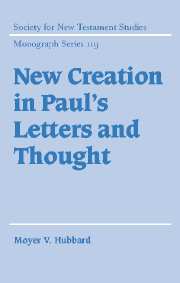Book contents
- Frontmatter
- Contents
- Acknowledgments
- List of abbreviations
- 1 Introduction: the current debate
- PART I NEW CREATION: CENTRAL JEWISH TEXTS
- Part II FROM DEATH TO LIFE: NEW CREATION IN THE CONTOURS OF PAUL'S THOUGHT
- Part III THE OLD AND THE NEW: NEW CREATION IN THE CONTEXT OF PAUL'S LETTERS
- References
- Index of passages cited
- Index of modern authors
1 - Introduction: the current debate
Published online by Cambridge University Press: 02 December 2009
- Frontmatter
- Contents
- Acknowledgments
- List of abbreviations
- 1 Introduction: the current debate
- PART I NEW CREATION: CENTRAL JEWISH TEXTS
- Part II FROM DEATH TO LIFE: NEW CREATION IN THE CONTOURS OF PAUL'S THOUGHT
- Part III THE OLD AND THE NEW: NEW CREATION IN THE CONTEXT OF PAUL'S LETTERS
- References
- Index of passages cited
- Index of modern authors
Summary
The current debate
The biblical story, from beginning to end, can rightly be described as an epic of new creation. As its prologue opens with Elohim's creation of heaven and earth, so its epilogue closes with the dramatic appearance of the new heaven and the new earth – a place where sorrow and death are no more, and where the dwelling place of God is with his people. Creatio originalis gives way to creatio nova as the one seated upon the throne announces, “Behold, I make all things new!” (Rev. 21.5). But this grand inclusio, while hopeful in its preface and jubilant in its finale, brackets a history of tohu wabohu. As early as Genesis 3 the battle lines are firmly fixed. The creature has shunned the creator, the creation groans in bondage to decay (Gen. 3.17–18; Rom. 8.19–22), and posterity is left with a legacy of despair: “O Adam,” laments Ezra, “what have you done? For though it was you who sinned, the fall was not yours alone” (4 Ezra 7.117; cf. Rom. 5.12–21). But before we let Heilsgeschichte degenerate into Angstgeschichte, it is worth recalling that the biblical story is a drama of redemption. And while the plot is not without its twists and turns, it does reach a fitting and moving climax in the passion narratives.
The motif of “newcreation,” however, is not confined to the opening and closing chapters of the Christian Scriptures. The prophets, the psalmists, the evangelists, and so on, all exhibit a robust faith in the creative activity of God, and this faith was not focused solely on the remote past or the distant future.
- Type
- Chapter
- Information
- New Creation in Paul's Letters and Thought , pp. 1 - 8Publisher: Cambridge University PressPrint publication year: 2002

